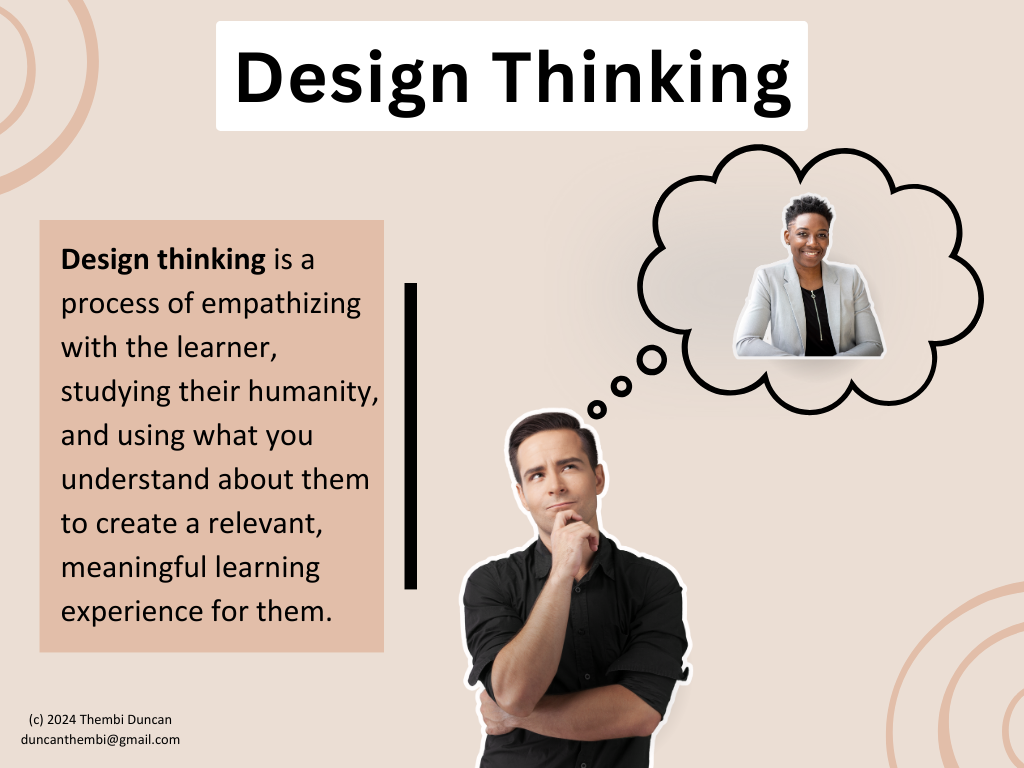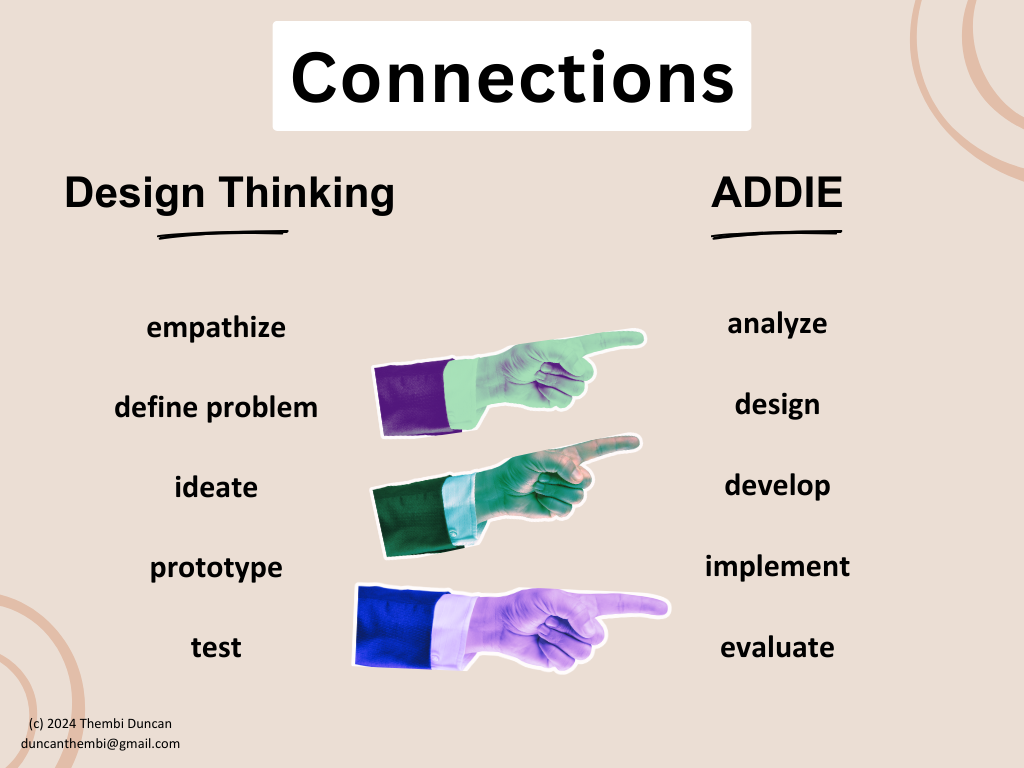Instructional Design
This collection showcases my work in Instructional Design (ID). As a professional theatre practitioner and educator, I bring a solid background of artistic and pedagogical competencies that allow me to stand out in the ID field as a dynamic and innovative contributor.
My ID learning journey began with exploring a “learn-by-doing” approach to the work, inspired by Karen Caldwell, Ed.D., and resulting in this portfolio that both represents and explains ID. Here, I describe critical tools that IDs use in our work, beginning with the A.D.D.I.E. Framework, which is considered by practitioners to be the dominant ID process. I then discuss Design Thinking, which I synthesize with A.D.D.I.E. and explain how the two can be used together.
Other ID concepts that I explore in this section include Action Mapping and Learner Personas.
After perusing my materials, please use the form at the end of this page to share feedback, ask questions, or arrange a conversation about solving a learning problem. To email me directly, contact me at duncanthembi@gmail.com.
The A.D.D.I.E. Framework
A.D.D.I.E. stands for Analysis, Design, Development, Implementation, and Evaluation. (ELM, 2022). The five stages of the A.D.D.I.E. Framework guide IDs toward organizing information, following a logical progression of tasks, and demonstrating the competency to design successful learning experiences. While this appears to be a linear process, IDs can return to previous steps in the progression to confirm the alignment of their project design with their established objectives and goals. They can also return to the Analysis stage after completing the Evaluation stage. Therefore, the A.D.D.I.E. Framework can also be depicted with a circular representation.
The infographics below describe each stage of the A.D.D.I.E. Framework. Click each infographic to enlarge it. From there, you can download the infographic or share it on social media.
Design Thinking
The Design Thinking framework is less fixed than A.D.D.I.E., which has five clear stages and a linear structure. Because of this difference, Design Thinking offers more flexibility and room for refinement before the learning experience design process is too far along for course corrections.
Connie Malamed (The eLearning Coach) offers a modified version of Stanford University’s d.school approach to Design Thinking: Empathize, Define the Problem, Ideate, Prototype, and Test (Malamed, 2020). What sets this approach apart from A.D.D.I.E, is that the Ideate, Prototype, and Test components of the process can be repeated and adjusted based on feedback and insights from the client and other key stakeholders of the learning experience.
This approach provides opportunity to problem-solve, respond to unexpected discoveries, and improve the overall learning experience.
Design Thinking and A.D.D.I.E.


Action Mapping and Learner Personas
Action Mapping
Action Mapping requires a paradigm shift in terms of how an instructional designer interprets the learning process. The ID needs to approach the situation as if they are solving a problem and not focus on pouring information into a learner’s head based on what the client has asked them to do. This may be different than what they learned in their program, so they will have to do their own additional research in order to connect to the actual performance problem that needs to be solved.
Action Mapping is a process, not a model. This is a series of questions that you ask. These questions are meant to get to the heart of what exactly the learner needs to do rather than what they need to know. In addition, the ID needs to understand why the learner is not doing what they’re supposed to do. Additional training may not be the solution. The only way to figure out the barriers to the performance is to ask questions about the learner’s tasks and responsibilities.
Traditional ID training often does not include information about how businesses operate or their key performance indicators (KPIs). This is insufficient for solving problems in today’s world. To supplement existing ID training and solve this problem, ID’s should conduct additional research outside of what they have learned from the business, and by setting up two separate meetings they can do this. The first meeting can be a quick introductory meeting, and then the second (longer) meeting can be scheduled for a week or two later, after the ID has had an opportunity to conduct research not only on that company, but on similar companies and how they have solved similar problems.
Learner Personas
Stanford University’s Office of Digital Accessibility offers resources to support the Design Thinking process, including a template for what they call Design Personas. Here I will call them Learner Personas, a term that represents an empathetic, access-focused approach to considering and designing for the need of learners.
By addressing disabilities, this tool facilitates a greater emphasis on accessibility and the acknowledgement of the full spectrum of disabilities and impairments.
Based on the Stanford model, I created two learner personas for a learning intervention with the following conditions:
Problem
Problem Statement: Employees encounter difficulties in analyzing and reporting accurate data analysis of student data due to lack of experience with data cleaning techniques.
Context
The learning context is the College of Arts and Sciences at the University at Buffalo, a 1,350-acre university in an inner-ring suburb of Buffalo, NY. The College is one of 13 schools inside the university and includes 30 departments, 16 academic programs and 23 centers and institutes. Each of the 30 departments employs 1-5 data analysts.
The Intervention
To address the problem, employees will examine data cleaning strategies within Microsoft Excel. Participants will practice data cleaning strategies leading to more accurate analysis of data sets.
Learning Persona #1: Isaiah Williams
Age: 38
Position: Data Analyst at the University at Buffalo (8 months)
Tech Savvy: High
Challenges: 1) Has trouble navigating complex spreadsheets due to color perception challenges. 2) Struggles to grasp relationships between data points on spreadsheets containing large amounts of data.
Solution: Use the Microsoft Office Accessibility tools for tips on making Excel documents accessible.
Perspective: “I understand the end game of gathering data in my department, but these overcomplicated spreadsheets that my boss sends me every week…well, to be honest, they just slow me down. Sometimes I feel like I’m just looking at a brick wall of information, and even though she provides me with explicit instructions, I’m still not sure I understand what she wants me to do with all that data. These challenges motivate me to find improvements, but after only 8 months in this position, I don’t feel comfortable asking for help. What if my boss thinks she made a mistake hiring me?”
Attitude about improving his data management skills: “I’d prefer to figure this out on my own, if I can. There has to be a way to gather and break down this data so that I can do my job efficiently. I hope to find a self-guided process for improving my skills in data management.”
Learning Persona #2: Katherine “Katie” Stalwart
Age: 45
Position: Data Analyst at the University at Buffalo (6 years)
Tech Savvy: Medium
Challenges: 1) With English as her second language, Katie has trouble understanding complex verbal and written instructions related to data management. 2) Despite feeling comfortable with her data management skills, Katie has received feedback suggesting that she is not reaching her goals. This represents a gap between her perceived performance and actual performance expectations from her supervisor.
Solution: Provide hands-on, visual, and written learning resources along with coaching and interactive tools to enhance her understanding of data management processes.
Perspective: “It’s frustrating to keep getting feedback that I’m missing my targets after feeling that I’ve got the hang of data management. I guess there’s a disconnect…and though I’m fluid in English, I wonder if some of the instructions I receive get lost in translation. I’m just not sure what’s going wrong.”
Attitude about improving her data management skills: “I’m sure I could use some improvement in terms of how I collect and evaluate data, but I don’t know where to look or who to ask. Also, I’m very busy with a wide range of duties that I have to focus on. I’ve been here too long to have these challenges. I wish someone could help me understand what the problem is.”
References
Cook, J. (2018a, January 16). Action Mapping Interview, Part 1 [Audio Podcast]. The TJ Podcast. https://anchor.fm/the-tj-podcast/episodes/Cathy-Moore-on-action-mapping-em80f5
Cook, J. (2018b, January 19). Action Mapping Interview, Part 2 [Audio Podcast]. The TJ Podcast https://anchor.fm/the-tj-podcast/episodes/Cathy-Moore-on-action-mapping-pt2-em80g1
ELM Learning. (2022 July 22). What is ADDIE? Your complete guide to the ADDIE model. eLearning Lab. https://elmlearning.com/blog/instructional-design-addie-model/)
Malamed, C. (2020). How to use design thinking in learning experience design. The E-Learning Coach. https://theelearningcoach.com/elearning_design/design-thinking-for-instructional-design/
Stanford University. (n.d.). Design Personas: Digital Accessibility Recommendations for Interactive Designs. Office of Digital Accessibility. https://uit.stanford.edu/accessibility/design-personas
Contact Me
Use this form to share feedback, ask questions, or schedule a conversation.
You can also email me directly at duncanthembi@gmail.com.







